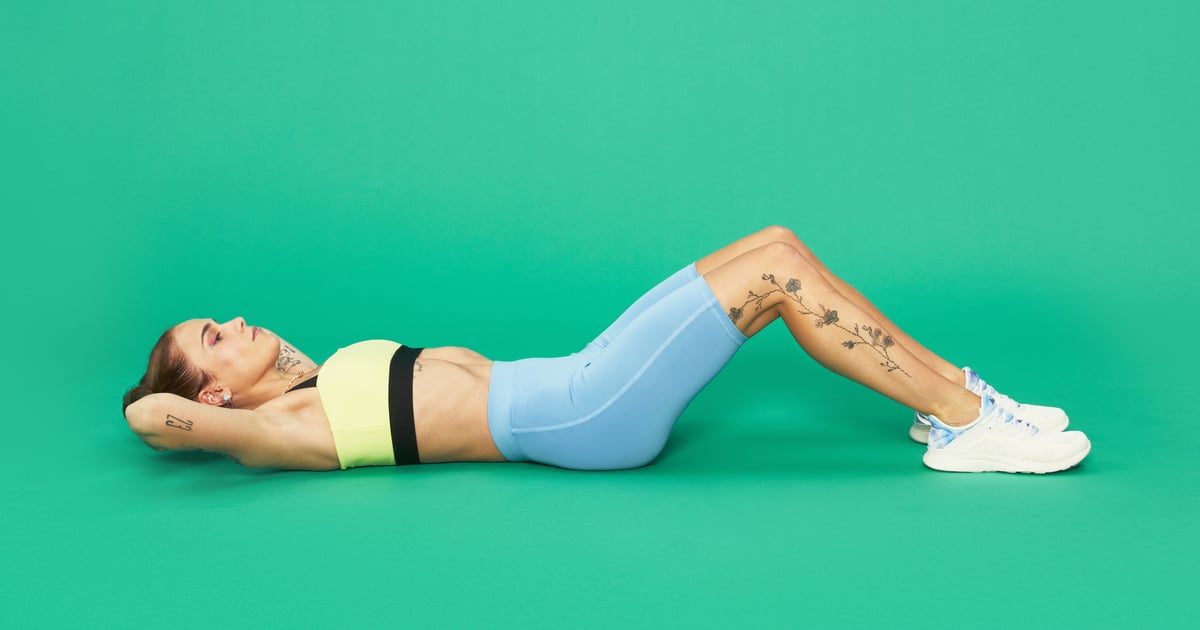Whether you’re a frequent or infrequent gym-goer, there’s a good chance you’ve done crunches. Crunches are a classic core-strengthening exercise. But while they may seem ubiquitous — heck, they’re even part of the dreaded Presidential Fitness Test — they aren’t the only way to strengthen your abs.
Like all exercises, crunches work best — and make you the least susceptible to injury — when they’re done with proper form. POPSUGAR spoke with Grace Taylor, PT, DPT at H&D Physical Therapy, to learn everything you need to know about this classic core move, including whether it’s actually worth your time, how to do crunches correctly, and plenty of crunch exercise variations that work your abs in different ways.
The Benefits of Crunches
Crunches utilize and strengthen your rectus abdominis (the ab muscle along the front of your stomach), internal and external obliques (which wrap around the sides of your stomach), transverse abdominis (your deepest, corset-like ab muscle), and hip flexors, Taylor says. The muscles utilized during crunches are important stabilizing muscles in the body. Better stability means better balance, lifting, postural control, and power production, plus minimized aches and pains, particularly in the lower back. Overall, a strong core supports just about every movement you do.
And the crunch movement does show up in your everyday life — think about how you get out of bed in the morning or get up from a couch or lying on the floor. Strengthening the muscles involved in this movement pattern will help you continue to execute it safely in your day-to-day.
Crunches Form Tips
There are two common positions for your hands while performing crunches, and Taylor has a preference. You can either place your hands behind your head, or you can cross your arms over your chest.
Placing your hands behind your head creates a longer lever arm and requires more intense core work. However, with this added challenge, it’s easier to use momentum, rather than strength, to complete your crunches. This can place a lot of pressure on the spinal segments in the neck and upper back. If you use this variation, ensure your arms remain inactive throughout the entire exercise, so you’re not pulling on your neck.
Placing your hands on your chest makes it easier to round your midback during the crunch, which can place more pressure on your spine and decrease your core use. However, this position is less likely to strain your spine than placing your hands behind your head, which is why Taylor recommends it.
To keep good form, Taylor recommends that you avoid tucking your chin toward your chest. A good way to avoid this is by finding a spot on the ceiling to keep your eyes on. Additionally, making sure you keep your low back flush with the ground is key. Sitting up too much can put a lot of strain on your spine and hips — if your back comes off the ground, know that you’ve gone too far. (That move is generally considered a “sit-up” rather than a crunch.)
Also, oftentimes when crunches are done absentmindedly, your hip flexors take over and pull on your lower-back muscles, which may cause spinal issues down the road, says Glo trainer Ridge Davis. And when they take over, they disengage your abs, making the crunch exercise far less effective as a core move. “It’s all about awareness when performing crunches — or any exercise for that matter,” Ridge says.
How to Do Crunches
With that in mind, it’s worth it to learn how to do crunches correctly. “My philosophy is that there is not a bad exercise but a poorly executed one,” Davis says. For a visual, watch Pilates instructor Isa Welly do this move properly, or follow the specific steps on how to do a crunch below.
- Lie on the floor with your back flat, both knees bent, and feet planted on the floor about shoulder-width apart. Cross your arms, and place your hands on your chest.
- Inhale, then exhale and activate your core muscles to lift your shoulder blades off the ground.
- Hold for a second, then inhale while slowly lowering your shoulder blades to the floor. That’s one rep.
Crunch Cautions and Modifications
Taylor confirmed what you may have already heard, that crunches are a heavily debated exercise. Like burpees, they can be beneficial if done property, but they can also put a lot of strain on your spine. Taylor doesn’t recommend crunches to people with a history of neck or back pain and recommends choosing a different core exercise if you have pain during, immediately after, or the day after you do crunches. The good news? We have some ideas for you right here.
Keep reading for some crunch exercise variations that target different parts of your core and can be better choices depending on your exercise history and ability.
— Additional reporting by Lauren Mazzo and Nicole Yi
